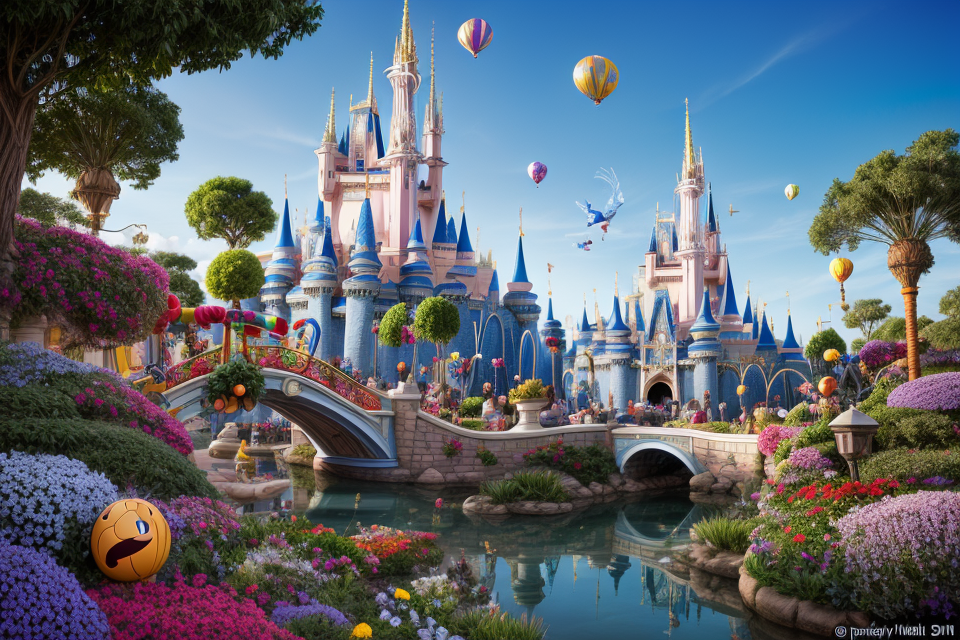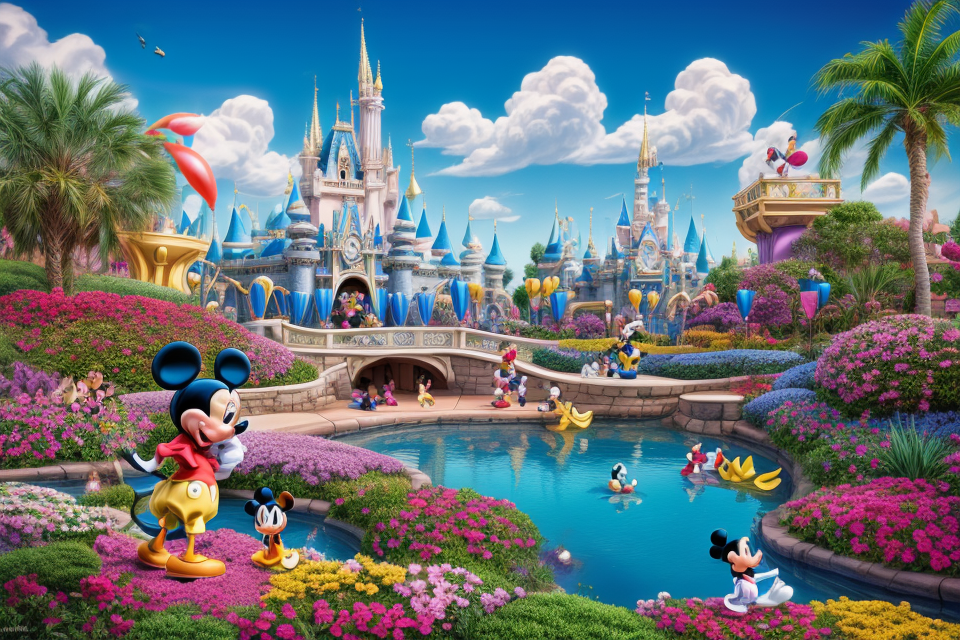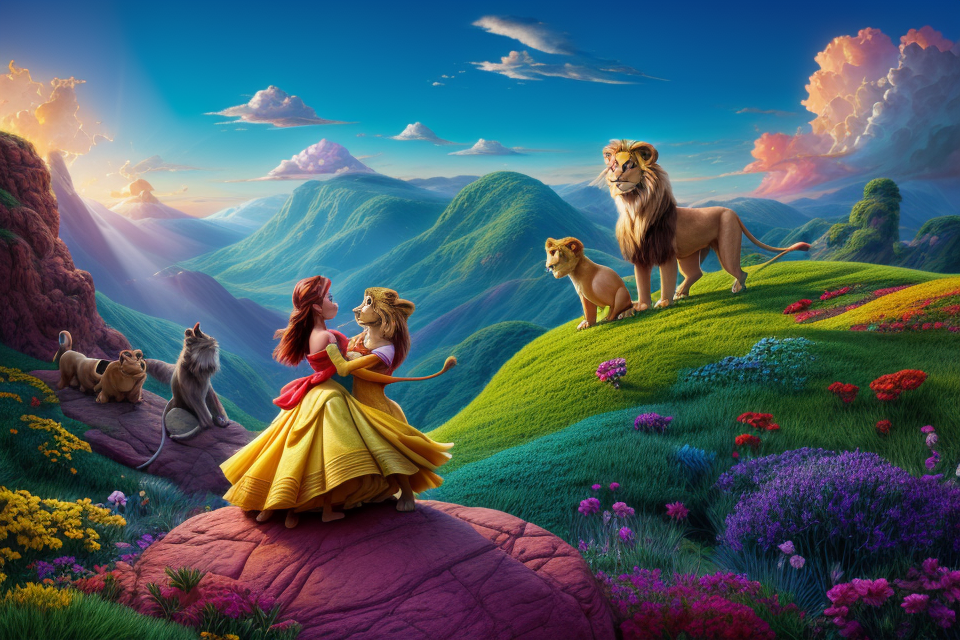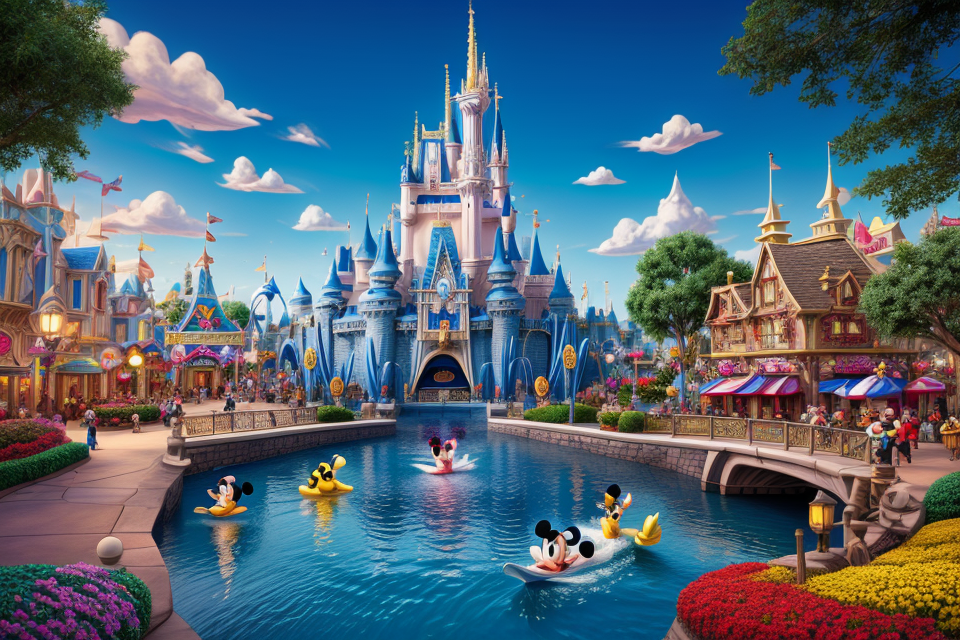
Once upon a time, in a small animation studio in California, a young Walt Disney had a vision. He wanted to create a new kind of entertainment that would captivate audiences around the world. Little did he know that his dream would become a reality and transform not only the entertainment industry but also the world itself. This is the story of how Disney’s magical creations changed the way we see and experience the world. From beloved characters like Mickey Mouse and Cinderella to groundbreaking technologies like virtual reality, Disney has left an indelible mark on our imaginations and our culture. Join us on a journey through the enchanted forests and magical kingdoms of Disney, and discover how a small animation studio became a global phenomenon that has impacted the world in ways both big and small.
The Early Years: From Mickey Mouse to Snow White
The Creation of Mickey Mouse
Walt Disney’s Early Career
Walt Disney was born on December 5, 1901, in Chicago, Illinois. He had a passion for drawing and animation from a young age, and he pursued this passion throughout his life. Disney dropped out of high school to join the army during World War I, but he was soon sent back to the United States due to his young age. After the war, Disney moved to Hollywood and began working in the film industry.
The Creation of Mickey Mouse
In 1928, Disney created his most famous character, Mickey Mouse. Mickey Mouse was a cartoon character that quickly became popular with audiences around the world. The first Mickey Mouse cartoon, “Plane Crazy,” was released in 1929, and it was an instant success. Mickey Mouse was unlike any other cartoon character at the time, and his unique personality and sense of humor captured the hearts of millions of people.
The Success of Mickey Mouse
The success of Mickey Mouse was due in large part to his appeal to both children and adults. Mickey Mouse was a lovable character who was always getting into funny situations, and his popularity helped to establish Disney as a major player in the animation industry. The success of Mickey Mouse led to the creation of many other beloved Disney characters, including Donald Duck, Goofy, and Snow White.
The First Animated Feature Film: Snow White and the Seven Dwarfs
The Development of Snow White
Snow White and the Seven Dwarfs was Walt Disney’s first feature-length animated film, and it was released in 1937. The film was based on the German fairy tale “Snow White” by the Brothers Grimm. Disney and his team of animators and artists spent over three years creating the film, which was a massive undertaking for the time. The film was directed by William Cottrell, with help from Walt Disney and other members of the animation team.
The animation was done by hand, with each frame drawn and painted individually. The process was labor-intensive and required a great deal of skill and attention to detail. The animators used a technique called “cell animation,” in which each frame is drawn on a transparent cell, which is then photographed and projected onto a screen to create the illusion of movement.
The film’s soundtrack was also innovative for its time. Disney hired a composer to create an original score for the film, which included music and sound effects. The use of sound was integral to the storytelling, and it helped to enhance the audience’s experience of the film.
The Release and Success of Snow White
Snow White and the Seven Dwarfs was released in 1937 and was an immediate success. The film was a critical and commercial hit, and it established Disney as a major player in the film industry. Snow White was the first animated film to be produced using the three-strip Technicolor process, which gave the film a vibrant and colorful look. The film’s success was due in part to its innovative use of sound and color, as well as its engaging story and memorable characters.
The film was also a financial success, earning over $8 million at the box office during its initial release. Snow White and the Seven Dwarfs was a risky project for Disney, as it was the studio’s first feature-length animated film. However, the film’s success proved that there was a market for animated films, and it paved the way for future Disney classics like Pinocchio, Fantasia, and Dumbo.
The Impact of Snow White on the Film Industry
Snow White and the Seven Dwarfs had a significant impact on the film industry and popular culture. The film established Disney as a leader in the animation industry and paved the way for future animated films. The success of Snow White also showed that animated films could be commercially successful and attract a wide audience.
The film’s innovative use of sound and color set a new standard for animated films and influenced the development of future animated films. Snow White also helped to establish the fairy tale genre as a popular and lucrative one, leading to a surge of fairy tale adaptations in the film industry.
Overall, Snow White and the Seven Dwarfs was a groundbreaking film that transformed the animation industry and had a lasting impact on popular culture. Its success paved the way for future Disney classics and established the animation studio as a leader in the film industry.
The Golden Age of Animation: From Bambi to Cinderella
The Evolution of Disney Animation
Disney animation has undergone a remarkable evolution over the years, transforming from a small animation studio into a cultural phenomenon that has captured the hearts of millions around the world.
The Artistic and Technical Advancements
One of the most significant evolutions in Disney animation has been the artistic and technical advancements made by the studio. Disney’s animators have consistently pushed the boundaries of what is possible in animation, experimenting with new techniques and styles to create visually stunning films. From the early days of hand-drawn animation to the development of computer-generated imagery (CGI), Disney has been at the forefront of animation technology.
The Influence of Disney Animation on the Film Industry
Disney animation has also had a profound influence on the film industry as a whole. The studio’s innovative techniques and storytelling have inspired countless other animators and filmmakers, and Disney’s films have often set the standard for quality and creativity in animation. The success of Disney’s animated films has also helped to establish animation as a legitimate art form, rather than just a niche genre.
The Popularity of Disney Animation
Perhaps most importantly, Disney animation has become a beloved part of popular culture around the world. Disney’s films have captured the hearts and imaginations of audiences of all ages, and the studio’s characters have become iconic figures in our culture. From Mickey Mouse and Donald Duck to Bambi and Cinderella, Disney’s characters have become a part of our collective consciousness, and their influence can be seen in everything from fashion and advertising to literature and music.
Overall, the evolution of Disney animation has been a remarkable journey that has transformed the world of animation and left an indelible mark on popular culture. As Disney continues to push the boundaries of animation technology and storytelling, it is clear that the magic of Disney animation will continue to captivate and inspire audiences for generations to come.
The Creation of Classic Animated Films
During the 1930s and 1940s, Disney’s animation studio produced some of the most iconic films in history. These classic animated films have stood the test of time and continue to captivate audiences today. Each film tells a unique story and features memorable characters that have become beloved by generations of fans.
- Bambi: The Relationship Between Man and Nature
- Bambi, released in 1942, tells the story of a young deer growing up in the forest. The film explores the relationship between man and nature and highlights the importance of understanding and respecting the natural world. Bambi’s journey from a helpless fawn to a strong and confident deer is a timeless tale of growth and perseverance.
- Cinderella: The Transformation of a Heroine
- Cinderella, released in 1950, is the classic story of a young woman who dreams of attending a royal ball. The film showcases the transformation of Cinderella from a downtrodden servant to a beautiful and confident princess. The story emphasizes the importance of believing in oneself and following one’s dreams, no matter how impossible they may seem.
- Pinocchio: The Tale of a Wooden Puppet’s Journey to Becoming a Real Boy
- Pinocchio, released in 1940, is the story of a wooden puppet who longs to become a real boy. The film follows Pinocchio’s journey as he navigates the trials and tribulations of life, learning valuable lessons along the way. The story emphasizes the importance of honesty, bravery, and the power of selflessness.
Overall, these classic animated films have left an indelible mark on popular culture and continue to inspire new generations of fans. They are a testament to the creativity, innovation, and vision of Disney’s animation studio during its golden age.
Disney’s Expansion into Live-Action Films and Theme Parks
The Creation of Disneyland
- The Inspiration for Disneyland
Walt Disney had always been fascinated by the idea of creating a place where he could bring his stories and characters to life. He had visited amusement parks as a child and remembered the feeling of wonder and excitement they had inspired in him. As he grew older, he began to imagine a park that would be even more magical, with rides, attractions, and shows that would transport visitors to fantastical worlds. - The Design and Construction of Disneyland
Disney enlisted the help of his talented team of artists, engineers, and imagineers to bring his vision to life. They worked tirelessly to design and build the park, using cutting-edge technology and innovative techniques to create a truly immersive experience. From the iconic castle to the enchanted forest, every detail was carefully crafted to transport visitors into a world of magic and wonder. - The Opening of Disneyland
On July 17, 1955, Disneyland opened its gates to the public for the first time. The park was an instant success, with people lining up for hours to experience the magic for themselves. Walt Disney himself was overwhelmed with emotion as he watched the crowds of happy visitors enjoying his creation. He knew that Disneyland was more than just an amusement park; it was a place where dreams could come true.
The Expansion of Disney into Live-Action Films
- The Success of Disney Live-Action Films
Disney’s expansion into live-action films marked a significant turning point in the company’s history. The success of Disney’s live-action films can be attributed to their ability to capture the hearts and imaginations of audiences around the world.
Classics such as “Mary Poppins” and “The Jungle Book” have become timeless favorites, while more recent releases like “Beauty and the Beast” and “The Lion King” have continued to reinforce Disney’s dominance in the film industry.
- The Influence of Disney Live-Action Films on Popular Culture
Disney’s live-action films have had a profound influence on popular culture. They have inspired countless imitators and parodies, and their songs and characters have become ingrained in the cultural consciousness.
The enduring popularity of Disney’s live-action films is a testament to their power to evoke nostalgia, wonder, and hope in audiences of all ages.
- The Importance of Disney Live-Action Films in the Film Industry
Disney’s live-action films have had a significant impact on the film industry as a whole. They have set the bar for family-friendly entertainment and have influenced the way that other studios approach the production of live-action films.
In addition, Disney’s success in the live-action film market has solidified their position as a dominant force in the entertainment industry, cementing their reputation as one of the most innovative and successful film studios in the world.
Disney’s Impact on Popular Culture and Society
The Influence of Disney on Popular Culture
Disney’s impact on popular culture is undeniable. The company’s creations have permeated society and continue to shape popular culture even today. Here are some examples of how Disney has influenced popular culture:
The Disney Princesses and Their Impact on Society
Disney princesses have become cultural icons and have influenced society in a number of ways. They have inspired countless little girls to believe in themselves and their dreams, and have helped to break down gender stereotypes. The princesses have also sparked a multibillion-dollar industry of princess-themed merchandise, from toys to clothing to accessories.
The Disney Villains and Their Impact on Society
Disney villains have also had a significant impact on popular culture. They have become iconic figures, with many people enjoying the thrill of rooting for the underdog and against the villain. The villains have also inspired countless Halloween costumes and makeup looks, and have even inspired a popular musical genre, known as “villain-pop.”
The Disney Characters and Their Impact on Popular Culture
Disney characters have had a profound impact on popular culture. They have become beloved icons and have inspired countless movies, TV shows, and books. Disney characters have also become popular mascots for a variety of events and causes, from sporting events to charity fundraisers. They have even inspired entire theme parks, such as Disneyland and Disney World.
Overall, Disney’s impact on popular culture is vast and far-reaching. The company’s creations have become an integral part of our cultural landscape, and continue to shape the way we think about and interact with the world around us.
The Influence of Disney on Society
Disney’s impact on society is a testament to the power of storytelling and imagination. The company’s ability to create beloved characters and worlds has had a profound effect on popular culture and the way we see the world.
The Impact of Disney on Childhood Development
Disney’s films and characters have become a staple of childhood for many generations. They provide a sense of wonder and imagination that can shape a child’s view of the world. The positive messages and morals conveyed in Disney’s stories can also help shape a child’s values and beliefs.
The Influence of Disney on Education
Disney’s impact on education is significant. Many schools use Disney films as teaching tools to help students learn about history, science, and other subjects. Disney’s educational programs, such as “Mickey Mouse Clubhouse” and “Handy Manny,” are designed to teach children important life skills and values.
The Impact of Disney on Tourism
Disney’s theme parks have become a popular destination for tourists from all over the world. The company’s ability to create immersive and magical experiences has helped to make it one of the most successful and recognizable brands in the world. Disney’s impact on tourism has also had a significant effect on the economies of the places where its parks are located.
The Legacy of Disney: From Walt Disney to the Present Day
The Legacy of Walt Disney
- The Vision and Innovation of Walt Disney
Walt Disney was a visionary who transformed the world of animation and entertainment. He was a master storyteller who used animation to bring his stories to life and captivate audiences. Disney’s innovative techniques, such as the use of sound and color in animation, revolutionized the film industry and paved the way for future animators. - The Impact of Walt Disney on the Film Industry
Walt Disney’s impact on the film industry cannot be overstated. He created a new form of entertainment that appealed to audiences of all ages. Disney’s films were not only entertaining, but they also had a positive message and taught valuable lessons. Disney’s films have been loved by generations and continue to be enjoyed by audiences today. - The Continued Legacy of Walt Disney
Walt Disney’s legacy continues to inspire and influence the film industry. Disney’s company, now known as The Walt Disney Company, is one of the largest and most successful film studios in the world. Disney’s films continue to be beloved by audiences and have been adapted into theme parks, television shows, and other forms of media. Walt Disney’s legacy lives on and continues to inspire future generations of filmmakers and animators.
The Evolution of Disney After Walt Disney
- The Transition of Disney After Walt Disney
- The Death of Walt Disney and the Transfer of Power
- The passing of Walt Disney and the subsequent power struggle within the company
- The impact of Walt Disney’s death on the company’s future
- The Appointment of a New Leadership
- The appointment of a new CEO and the changes that followed
- The challenges faced by the new leadership in maintaining the company’s legacy
- The Death of Walt Disney and the Transfer of Power
- The Continued Success of Disney After Walt Disney
- The Expansion of Disney’s Business Ventures
- The expansion of Disney’s business ventures beyond animation and into other industries
- The acquisition of ABC and the creation of ESPN
- The Development of New Technologies
- The development of new technologies to enhance the Disney experience
- The introduction of Disney’s first theme park, Disneyland
- The Expansion of Disney’s Business Ventures
- The Future of Disney
- The Current State of Disney
- The current state of Disney and its position in the entertainment industry
- The challenges faced by Disney in the current market
- The Predictions for Disney’s Future
- The predictions for Disney’s future growth and expansion
- The potential for Disney to continue to transform the world of entertainment
- The Current State of Disney
The Continued Impact of Disney on Popular Culture and Society
The Enduring Popularity of Disney
Despite the passage of time, Disney’s enduring popularity remains undeniable. From classic films like “Snow White” and “Cinderella” to modern-day hits like “Frozen” and “Moana,” Disney’s stories continue to captivate audiences of all ages. This timeless appeal can be attributed to the universal themes of love, friendship, and the triumph of good over evil that permeate Disney’s films. Additionally, the high-quality animation and memorable soundtracks have helped to ensure that Disney’s films remain a beloved part of popular culture.
The Influence of Disney on Future Generations
Disney’s impact on popular culture extends far beyond the realm of film. The company’s iconic characters and stories have permeated every aspect of modern society, from toys and clothing to theme parks and live-action adaptations. This influence can be seen in the countless Disney-themed products that fill store shelves, as well as in the countless Disney-inspired Halloween costumes that are donned by children each year. Furthermore, Disney’s influence on the entertainment industry has been significant, with many other studios following in its footsteps and producing family-friendly content that appeals to audiences of all ages.
The Future of Disney and Its Impact on Society
As Disney continues to evolve and adapt to changing times, it remains a dominant force in popular culture. With the acquisition of properties like Marvel and Star Wars, Disney has expanded its reach and continued to produce some of the most successful films of all time. However, as society becomes increasingly diverse, it remains to be seen how Disney will adapt to meet the changing needs and interests of its audience. Nonetheless, the continued impact of Disney on popular culture and society is undeniable, and its legacy is sure to endure for generations to come.
FAQs
1. How did Disney impact the world?
Disney has had a profound impact on the world in many ways. Through its films, theme parks, and other media, Disney has influenced popular culture, inspired creativity, and brought joy to billions of people around the world. Disney has also been a leader in technological innovation, pushing the boundaries of what is possible in animation, special effects, and immersive experiences.
2. What is the history of Disney?
Disney was founded in 1923 by Walt Disney and his brother Roy Disney. The company started as an animation studio, producing short films and cartoons. Over the years, Disney expanded into feature films, television, theme parks, and other ventures, becoming one of the most successful and influential media companies in the world.
3. How has Disney influenced popular culture?
Disney has had a significant impact on popular culture, particularly in the realm of entertainment. Disney films, characters, and music have become part of the cultural fabric of society, influencing fashion, language, and even social norms. Disney has also been a major force in shaping the way we think about and experience storytelling, using a combination of imaginative plots, memorable characters, and cutting-edge technology to create immersive and unforgettable experiences.
4. What is the role of technology in Disney’s success?
Technology has played a crucial role in Disney’s success, particularly in the realm of animation and special effects. Disney has always been at the forefront of technological innovation, using the latest tools and techniques to create stunning visuals and immersive experiences. From the earliest days of animation to the development of cutting-edge theme park attractions, Disney has consistently pushed the boundaries of what is possible, using technology to create a sense of wonder and magic that has captivated audiences around the world.
5. What are some of Disney’s most famous creations?
Disney has created many iconic characters and stories over the years, including Mickey Mouse, Donald Duck, Snow White, Cinderella, The Lion King, and Frozen, among many others. These characters and stories have become part of the cultural fabric of society, inspiring generations of fans and influencing countless other works of art and entertainment.
6. What is the significance of Disney’s theme parks?
Disney’s theme parks have had a profound impact on the world of entertainment and tourism. The first Disney theme park, Disneyland, opened in 1955 and quickly became a beloved destination for families and fans of Disney. Since then, Disney has opened numerous other theme parks around the world, each offering a unique and immersive experience that combines cutting-edge technology, imaginative storytelling, and classic Disney characters and attractions. These theme parks have become beloved destinations for millions of visitors each year, inspiring a sense of wonder and magic that has captured the imaginations of people of all ages.


